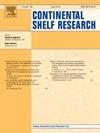沙特阿拉伯红海沿岸Obhur泻湖沉积物中天然脂肪脂和固醇的浓度、空间分布和来源
IF 2.2
3区 地球科学
Q2 OCEANOGRAPHY
引用次数: 0
摘要
从位于吉达北部的Obhur泻湖表层沉积物中收集样本,分析天然脂质的浓度、空间分布和来源。根据其周围生态系统,将泻湖划分为三个区域:Z I(毗邻内陆地区),Z II (Z I与沿海Z III之间的过渡区域)和Z III(沿海地区)。在总可萃取有机物(TEOM)中发现的主要天然生物脂质化合物包括正构烷烃(部分)、脂肪酸、脂肪醇和类固醇。生物源正构烷烃主要来源于陆生高等植物蜡,从第1期的38%下降到第3期的12%。相反,从Z I到Z III,水生藻类和硅藻的贡献从大约1%增加到8%,而微生物的投入在相同的区域从大约3%到0.5%下降。高等植物脂肪酸的相对浓度各不相同,在Z I中约占6%,Z II中占4%,Z III中占5%。在所有区域,水生藻类来源的贡献约为80%,微生物输入从Z I到Z III略有下降,从14%降至12%。陆地输入的脂肪正醇从Z I的32%下降到Z III的11%,水生藻类和硅藻的贡献从Z I的62%下降到Z III的45%,微生物输入保持在10%左右。陆生植物的类固醇输入量从第1期的37%下降到第3期的16%,而水生生物群的类固醇输入量从第1期的58%上升到第3期的76%。III区类固醇微生物输入量最高(11.5%),II区次之(9.9%),I区次之(9.4%)。陆源对天然脂质的贡献从第1期的42.8%下降到第3期的19.2%,而水生源对天然脂质的贡献从第1期的53.0%上升到第3期的77.4%。这些结果表明,泻湖的生物地球化学受到周围生态系统、泻湖水动力和当地人类和社会活动的影响。本文章由计算机程序翻译,如有差异,请以英文原文为准。
Concentrations, spatial distributions, and origins of natural aliphatic lipids and sterols in sediments of Obhur Lagoon, Red Sea Coast, Saudi Arabia
Samples from the upper surface sediments of Obhur Lagoon, located north of Jeddah, were collected to analyze the concentrations, spatial distribution, and origins of natural lipids. The lagoon was segmented into three zones based on their surrounding ecosystems: Z I (adjacent to inland areas), Z II (the transitional region between Z I and the coastal Z III), and Z III (the coastal region). The primary natural biogenic lipid compounds found in the total extractable organic matter (TEOM) included n-alkanes (partial), fatty acids, fatty alcohols, and steroids. The n-alkanes of biogenic origin were primarily derived from terrestrial higher plant wax, decreasing from approximately 38% in Z I to 12% in Z III. Conversely, contributions from aquatic algae and diatoms increased from about 1% to 8% from Z I to Z III, while microbial inputs declined from roughly 3%–0.5% over the same zones. The relative concentrations of fatty acids from higher plants varied, accounting for about 6% in Z I, 4% in Z II, and 5% in Z III. Aquatic algae sources contributed approximately 80% in all regions, and microbial inputs slightly decreased from 14% to 12% from Z I to Z III. Terrestrial inputs of fatty n-alcohols declined from around 32% in Z I to 11% in Z III, while contributions from aquatic algae and diatoms decreased from about 62% to 45% from Z I to Z III, with microbial inputs remaining around 10%. Steroid inputs from terrestrial plants decreased from 37% in Z I to 16% in Z III, while those from aquatic biota increased from 58% in Z I to 76% in Z III. The microbial inputs of steroids were highest in Z III (11.5%), followed by Z II (9.9%) and Z I (9.4%). The total natural lipid contributions from terrestrial sources decreased from 42.8% in Z I to 19.2% in Z III, while the aquatic source component increased from 53.0% in Z I to 77.4% in Z III. These results suggest that the lagoon's biogeochemistry is influenced by the surrounding ecosystems, lagoon hydrodynamics, and local human and social activities.
求助全文
通过发布文献求助,成功后即可免费获取论文全文。
去求助
来源期刊

Continental Shelf Research
地学-海洋学
CiteScore
4.30
自引率
4.30%
发文量
136
审稿时长
6.1 months
期刊介绍:
Continental Shelf Research publishes articles dealing with the biological, chemical, geological and physical oceanography of the shallow marine environment, from coastal and estuarine waters out to the shelf break. The continental shelf is a critical environment within the land-ocean continuum, and many processes, functions and problems in the continental shelf are driven by terrestrial inputs transported through the rivers and estuaries to the coastal and continental shelf areas. Manuscripts that deal with these topics must make a clear link to the continental shelf. Examples of research areas include:
Physical sedimentology and geomorphology
Geochemistry of the coastal ocean (inorganic and organic)
Marine environment and anthropogenic effects
Interaction of physical dynamics with natural and manmade shoreline features
Benthic, phytoplankton and zooplankton ecology
Coastal water and sediment quality, and ecosystem health
Benthic-pelagic coupling (physical and biogeochemical)
Interactions between physical dynamics (waves, currents, mixing, etc.) and biogeochemical cycles
Estuarine, coastal and shelf sea modelling and process studies.
 求助内容:
求助内容: 应助结果提醒方式:
应助结果提醒方式:


